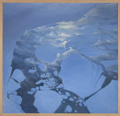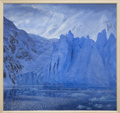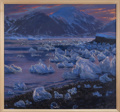These paintings from the Arctic Ocean feature scenes from a scientific research trip in 1988. David sailed on Northwind, the last of the Wind-class icebreakers, as part of the US Coast Guard Art Program. One of the icebreaker’s final missions before being decommissioned was to escort the research ship Polarbjorn as far as possible into the ice pack of the Arctic Ocean above Spitsbergen, Norway. Polarbjorn was left at almost 83 degrees north to freeze in the ice with scientific researchers aboard. As the vessel drifted, the scientists could observe the freezing of the ice and then the melting of the ice pack, as the polar gyre pushed the ice south into the warm Spitsbergen current.
At that time in the late 1980s, the polar ice cap was made up of very densely packed multi-year ice floes. Salt drains out of sea ice over a few seasons, resulting in dense, almost freshwater ice that is difficult to navigate, even with an ice breaker. Since 1988, the ice has been melting more in the summer and there is less multi-year ice. In the very near future, there will be no summer sea ice and therefore no permanent polar ice cap. It is feared that the resulting expanse of open water will absorb far more heat from the sun than the reflective sea ice, accelerating Arctic warming.
David’s paintings from the Arctic ice cap in 1988 show jumbles of multi-year ice floes, pressure ridges, and areas of open water known as polynyas, with drifting ice lit by ethereal high-latitude sunrise and sunset light. If he were to return to the same areas today, he would likely observe only open water in late summer.
Please proceed to audio tour location 7.







